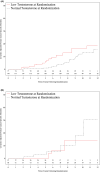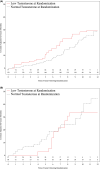Low Testosterone Level and Mortality Risk in Patients With Prostate Cancer: A Post-Randomization Analysis
- PMID: 40747769
- PMCID: PMC12314635
- DOI: 10.1002/cam4.71124
Low Testosterone Level and Mortality Risk in Patients With Prostate Cancer: A Post-Randomization Analysis
Abstract
Background: A low serum testosterone can prolong the time needed for PSA to exceed normal and prompt a work-up to rule out prostate cancer (PC), delaying diagnosis. We evaluated PC aggressiveness at diagnosis and PC-specific and all-cause mortality (PCSM, ACM)-risk within comorbidity subgroups in patients with low versus normal testosterone.
Methods: Between 2005 and 2015, 350 PSA-screened patients with tumor (T) category1c-4N0M0 unfavorable-risk PC were enrolled in a randomized trial and comprised the study cohort. Fine and Gray and Cox multivariable regression analyses were used to evaluate PCSM and ACM risk, respectively, adjusting for age, known PC prognostic factors, randomized treatment arm, and the time-dependent use of salvage androgen deprivation therapy. An interaction term between the Adult Comorbidity Evaluation-27 defined comorbidity and low versus normal testosterone was included in the models to enable an assessment of PCSM and ACM risk within comorbidity subgroups in patients with low versus normal testosterone levels at randomization.
Results: After a median follow up of 10.20 years, 89 of 350 patients died (25.43%) with 42 of 89 deaths (47.19%) from PC. In patients with no or minimal but not moderate to severe comorbidity, a significant association was observed between low compared to normal testosterone level at randomization and increased PCSM (AHR: 2.70 [95% CI: 1.27, 5.76], p = 0.01) and ACM risk (AHR: 1.90 [95% CI: 1.11, 3.26], p = 0.02).
Conclusion: Unlike PSA, multiparametric MRI (mpMRI) images are not influenced by the serum testosterone level; therefore, evaluating whether PCSM can be reduced by incorporating mpMRI into PC-screening in otherwise healthy men or transgender women with a low serum testosterone level should be considered.
Trial registration: The statisical code used to derive the results from the interaction model for this post randomization analysis can be found in the Supporting Information.
Keywords: mortality; prostate cancer; prostate‐specific antigen; testosterone; transgender.
© 2025 The Author(s). Cancer Medicine published by John Wiley & Sons Ltd.
Conflict of interest statement
The authors declare no conflicts of interest.
Figures



References
-
- Dai B., Qu Y., Kong Y., et al., “Low Pretreatment Serum Total Testosterone Is Associated With a High Incidence of Gleason Score 8‐10 Disease in Prostatectomy Specimens: Data From Ethnic Chinese Patients With Localized Prostate Cancer,” BJU International 110, no. 11 Pt B (2012): E667–E672, 10.1111/j.1464-410X.2012.11465.x. - DOI - PubMed
Publication types
MeSH terms
Substances
LinkOut - more resources
Full Text Sources
Medical
Research Materials
Miscellaneous

